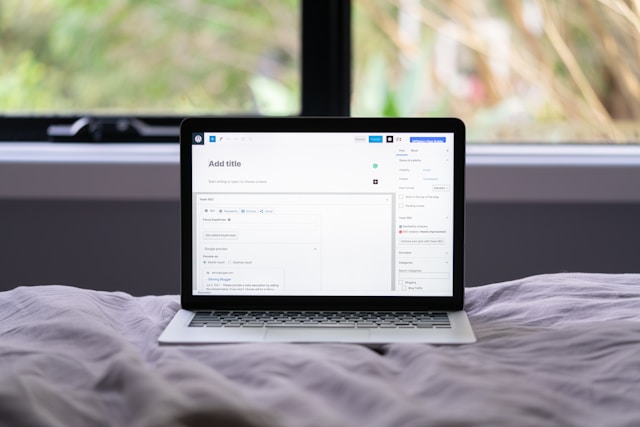How I Use The Competitor Backlinks Link Building Strategy To Secure Over 20 Backlinks Each Week
Link building is still going strong. Even though some SEOs might disagree on the impact that high-quality backlinks have on your website’s rankings, it is not a tactic that you can simply ignore if you’re looking to reach the top spots in SERPs.
Quick Links
Whether you’re looking to perk up your existing website or setting up a new business, having a well-ranked website is absolutely essential for making money online.
I have been building backlinks for our website for around a year and a half now. And, as the title suggests, my favorite strategy is competitor backlinks.
In this article, I will show you exactly how I have been building 20 links on average every single week, on my own.
- Have Five Email Accounts Doing Outreach Simultaneously
The average reply rate for link building is only 10%. And some of those replies are going to be negative.
So, in order to scale things up, you will need to send out hundreds of emails on a daily basis.
But there is a slight problem with sending so many emails all the time: you will get flagged as a spammer. And of course, you don’t want that.
So, to work around that, I have five different email accounts sending out smaller batches of emails.
Usually, I don’t send out any more than 45 daily emails with at least a 5-minute delay between them.
That’s 45 times 5 times 5, making it for 1125 emails every single week.
It is an absolutely tremendous amount, but I am a full-time link builder, after all.
- Warm Up Your Email Accounts
Regardless of the purpose of your outreach, before you can really start sending out campaigns, you need to warm up your email addresses.
Email warmup entails two things:
- Starting your outreach with a small number of daily emails and slowly increasing it week by week.
- Using an email warmup service to boost your email reputation and deliverability.
For your first week, I recommend starting with 10-15 daily emails, and slowly working your way up to 45-50 over the course of a month.
As for email warmup tools, I recommend Lemwarm. It works by connecting you with a network of their users, and sending them emails on your behalf.
From their side, the tool automatically responds to your email. If it lands in their spam folder, it also automatically marks it as not spam.
As a result, your ISP sees that your open and reply rates are increasing, which leads to your email reputation receiving a boost as well. This, in turn, affects the deliverability rates of your actual email campaigns.
Even after your first month of warming up, it is still a good idea to periodically turn the warmup tool on to keep your deliverability high.
- Find Prospects
The prospecting part is what makes the competitor backlinks strategy my personal favorite.
It takes considerably less time than the prospecting stage of a lot of other link-building strategies, like the anchor text strategy and even guest posting.
This is because we work in a pretty saturated niche – SaaS/marketing, so there is no shortage of competing content with a bunch of backlinks.
There are two ways to find prospects for this strategy, and both involve using backlink monitoring software like Ahrefs or SEMRush.
First, of course, you need to pick an article of yours that you will be building links to.
The first approach is to simply google your target keyword, and check competing articles’ backlinks one by one. Please note that search results will vary depending on your region. By doing this analysis, a no-log VPN can help you while also maintaining your online privacy and security.
Usually, the content with the most backlinks will be closest to the first position, but it’s not always the case.
This way, you can find hundreds, if not thousands, of link building prospects in just a few minutes, depending on the density of your target keyword.
The second approach is to make use of Ahrefs’ Content Explorer function, or similar alternatives.
Just type in your target keyword, and the tool will give you all of the content associated with it. If you filter it by the number of referring domains, you will get the juiciest link opportunities right at the top, saving you a bunch of time.
Export their backlinks, clean up the sheet from any irrelevant opportunities (I delete anything that has a DR of lower than 30), and you’re good to go.
- Prepare Your Email Sequence
The next step in launching a competitor backlinks outreach campaign is to prepare your email sequence.
There are many ways to phrase it, but the most important aspects of your pitch are:
- Who you are and why you are reaching out to your prospect;
- What you want from them;
- What can you offer in return for that link?
The last part, also referred to as the value proposition is arguably the most important part of your pitch. In case you are not sure will your proposition work or not, you can always test various options with a/b testing which is quite often used by startups.
In 2022, 99% of people will not give you a link for free, so you need to make sure to offer them something equally as valuable.
There are various things you can offer them in return:
- A reciprocal link (not recommended as it will hurt your SEO);
- Free access to your tool if you have one;
- An indirect link back (from another website or from one of your upcoming guest posts);
- Money (not recommended);
- Social shares.
Personally, I always offer an indirect link back from one of my guest posts since I’m writing a couple every week anyway.
We used to also provide links from our own blog, but it really hampered our traffic growth.
As soon as we started removing unnecessary outgoing links from our website, the traffic picked up as well.
5. Find Prospects’ Contact Information
This is arguably the most time-consuming part of the whole process if you don’t use any sort of automation.
There are many different tools available for finding people’s email addresses, like Hunter, Snov, Norbert, and others.
Personally, I use Respona because it is our own product, and besides the contact finding aspect, it also automates every other step of the outreach process, from prospecting to personalizing pitches.
You just upload the list of URLs to Respona, tell it who you’re looking for (editors, writers, content managers, etc.), and let the contact automation run for a couple of hours.
6. Personalize Pitches And Launch The Campaign
The last step before launching the campaign is giving each message a little individual touch.
Start with the simple things like addressing your prospect with their first name, and asking simple questions like “How is your {day_of_week} going?”.
The goal here is to make them think that the message was actually sent manually and not automatically, and little things like this really help with that.
Of course, more personalization like mentioning something they discuss in their article is always a huge plus, but when sending over a thousand emails every week, the time needed to do that stacks up dramatically.
There are even AI content tools out there that make this even easier to do; though whatever tool you use, and whether or not you use an AI tool, make sure you also have Grammarly (free version is enough) to check for spelling errors.
Because all the personalization in the world won’t help if your email is riddled with misspellings.
Rinse And Repeat!
It takes a long time and a lot of effort before you start seeing the results of your link-building campaigns.
So, my final advice here is to keep going! If you’re working with a team, document your practices with standard operating procedures (SOPs). Even though I only discussed the competitor backlinks strategy as my favorite, it is definitely a great idea to throw in some other SEO strategies like guest posting and the anchor text strategy in your link building mix to maximize results.
Author’s Bio:

Managing brand partnerships at Respona, Vlad Orlov is a passionate writer and link builder. Having started writing articles at the age of 13, their once past-time hobby developed into a central piece of their professional life.
Common Data Migration Challenges and How to Overcome Them
In the era of technology, data serves as the backbone of companies. Whether it's client details,…
0 Comments13 Minutes
SIEM at a glance (Security information and event management)
You have a contingency plan like most other intelligent businesses, but what if it fails? And,…
0 Comments12 Minutes
Breaking the Mold: Unconventional Methods for Business Growth with WordPress
If you have implemented WordPress for your website, or are considering migrating to it, chances…
0 Comments13 Minutes
Web and Mobile App Development Trends to Consider in 2024
As technology continues to evolve at a rapid pace, staying ahead is essential for developers and…
0 Comments8 Minutes
What Are the Top 10 Web Development Tools for Beginners?
Web development is the art of building and updating web pages that Internet users Interact with.…
0 Comments13 Minutes
Does Your Branding Need A New Look?
From time to time, it’s important and necessary to check over your branding, to ensure that it is…
0 Comments4 Minutes
Essential Skills for AI-Driven Digital Marketing
Digital marketing is changing a lot. Artificial intelligence (AI) is becoming really powerful and…
0 Comments10 Minutes
A Handbook for Crafting Outstanding Email Automation Plans
Email marketing is an essential tool for communication in digital marketing platforms. Managing…
0 Comments8 Minutes








